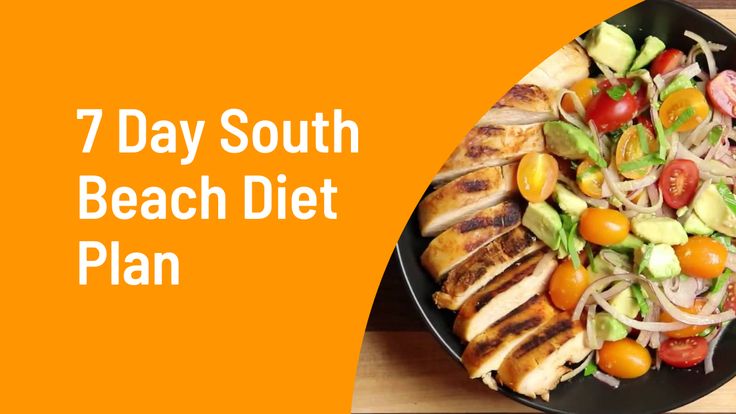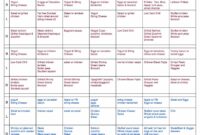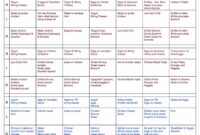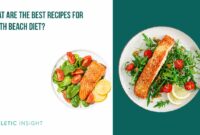South Beach Diet Week 1 marks the beginning of a transformative journey towards healthier eating habits. This initial phase focuses on eliminating unhealthy fats and refined carbohydrates, emphasizing lean proteins, healthy fats, and plenty of non-starchy vegetables. Understanding the permitted and restricted foods, along with creating balanced meal plans, is crucial for success. This guide will navigate you through the first week, offering sample meal plans, recipes, and strategies to overcome potential challenges.
The South Beach Diet’s first week emphasizes a low-glycemic approach, aiming to stabilize blood sugar levels and reduce cravings. By focusing on nutrient-rich foods, you’ll experience sustained energy and potentially see early weight loss. This initial phase sets the stage for long-term success by establishing healthy eating patterns and providing a solid foundation for the subsequent weeks of the diet.
Potential Challenges and Solutions in Week 1
Embarking on the South Beach Diet, particularly the first week, often presents several hurdles. Understanding these common challenges and developing proactive strategies is crucial for successful weight management and adherence to the program. This section will outline potential difficulties and provide practical solutions to help you navigate the initial phase of your dietary journey.
Managing Carbohydrate Cravings
The initial restriction of certain carbohydrates can trigger intense cravings. These cravings are often a result of the body’s adjustment to reduced sugar and refined carbohydrate intake. To mitigate this, focus on incorporating foods rich in healthy fats and protein to promote satiety and curb cravings. For example, a handful of almonds or a small portion of Greek yogurt can effectively satisfy hunger pangs and reduce the urge to reach for less healthy options. Furthermore, staying hydrated by drinking plenty of water can often alleviate the feeling of hunger, mistaking thirst for appetite. Planning your meals and snacks ahead of time can also help prevent impulsive decisions driven by cravings.
Adjusting Portion Sizes
The South Beach Diet emphasizes portion control. Many individuals find it challenging to adjust to smaller portions, especially those accustomed to larger serving sizes. A helpful strategy is to use smaller plates and bowls to visually manage portion sizes. Paying close attention to hunger and fullness cues is equally important. Avoid eating until overly full, instead, stop when you feel comfortably satisfied. Consider measuring your food initially to understand appropriate serving sizes, gradually adjusting your perception of what constitutes a proper portion.
Troubleshooting Guide for Common Problems
| Problem | Solution |
|---|---|
| Intense Hunger | Increase protein and healthy fat intake; Drink plenty of water; Consider adding more fibrous vegetables to meals. |
| Fatigue | Ensure adequate sleep; Stay hydrated; Focus on nutrient-dense foods to provide sustained energy. |
| Headaches | This could be related to dehydration or sugar withdrawal. Increase water intake and consume foods rich in magnesium and potassium. |
| Constipation | Increase fiber intake through vegetables and fruits; Drink plenty of water; Consider a mild laxative if necessary (consult your doctor). |
| Difficulty Sticking to the Plan | Prepare meals in advance; Have healthy snacks readily available; Find a support system or accountability partner. |
Physical and Mental Effects in Week 1
Embarking on the South Beach Diet can bring about noticeable shifts in both your physical and mental well-being during the initial week. Understanding these changes, both positive and negative, is crucial for successful adherence to the program. This section will explore the typical physical and mental experiences reported by individuals starting the South Beach Diet, providing context and comparison to other dietary approaches.
Physical Effects During Week 1
The first week on the South Beach Diet often involves noticeable changes in energy levels and potential initial weight loss. Many individuals report experiencing increased energy, potentially due to the diet’s emphasis on complex carbohydrates and lean protein, which provide sustained energy release compared to simple sugars. This contrasts with some other diets, like very low-calorie diets, which can lead to fatigue and decreased energy levels in the initial phase. Weight loss during the first week is often attributed to fluid loss and the reduction of glycogen stores (stored carbohydrates) in the body. This is common in many diets that restrict carbohydrates. However, it’s important to note that this initial weight loss is not solely fat loss. For example, a person might see a 2-3 pound weight loss in the first week, with a significant portion being water weight. This should be considered normal and expected, and not necessarily indicative of significant long-term fat loss.
Mental Effects During Week 1
Mentally, the first week can be a mixed bag. Some individuals report improved mood and increased focus, possibly linked to stabilized blood sugar levels resulting from the diet’s emphasis on complex carbohydrates. Others might experience increased cravings, particularly for sugary foods and processed carbohydrates, which are restricted in the initial phase. These cravings are often a result of the body adjusting to a new dietary pattern. The intensity of cravings can vary greatly depending on an individual’s prior dietary habits and willpower. In contrast to some restrictive diets that might lead to irritability and mood swings due to nutrient deficiencies, the South Beach Diet, with its focus on nutrient-rich foods, often results in milder mental side effects. For instance, a comparison to a very low-fat diet might reveal less pronounced irritability or depression in the South Beach Diet’s initial phase, due to the allowance of healthy fats.
Comparison to Other Diets
The South Beach Diet’s initial phase tends to be gentler on the body and mind compared to some other restrictive diets. While many diets lead to initial energy dips and significant mood swings, the South Beach Diet’s balanced approach, allowing for healthy fats and proteins, helps to mitigate these effects. The focus on whole, unprocessed foods also contributes to a more stable energy supply and fewer nutrient deficiencies, which can cause irritability and fatigue in other diets. For instance, compared to a very low-carbohydrate ketogenic diet, the South Beach Diet’s more gradual carbohydrate reduction may lead to fewer instances of “keto flu” (symptoms like headache, fatigue, and nausea) in the initial stages. It’s important to remember that individual responses to any diet can vary widely.
Shopping List for South Beach Diet Week 1
This shopping list provides a sample of foods suitable for the first week of the South Beach Diet. Remember to adjust quantities based on your individual needs and caloric goals. This list prioritizes whole, unprocessed foods that are low in carbohydrates and high in protein and healthy fats. Always check food labels to ensure they align with the diet’s guidelines.
Produce
The South Beach Diet emphasizes plenty of non-starchy vegetables. These provide essential vitamins, minerals, and fiber while keeping carbohydrate intake low. Aim for a variety of colors for optimal nutrient intake.
- Leafy Greens: Spinach (5 oz), Kale (5 oz), Romaine Lettuce (1 head)
- Cruciferous Vegetables: Broccoli (1 head), Cauliflower (1 head), Brussels sprouts (1 lb)
- Other Vegetables: Bell peppers (3), Celery (2 stalks), Cucumber (1), Onions (2), Asparagus (1 bunch), Mushrooms (8 oz)
- Avocado (2)
- Tomatoes (2 lbs)
Proteins
Protein is crucial for satiety and maintaining muscle mass. Choose lean protein sources to keep your meals healthy and low in fat.
- Chicken Breast (3 lbs): Versatile and easy to prepare in various ways.
- Salmon (1 lb): A great source of omega-3 fatty acids.
- Eggs (1 dozen): A convenient and protein-packed option for breakfast or snacks.
- Turkey Breast (1 lb): Lean and flavorful alternative to chicken.
- Extra-Lean Ground Beef (1 lb): Use sparingly, opting for leaner cuts.
Healthy Fats
Healthy fats are essential for hormone production and overall health. Incorporate these into your meals for sustained energy and satiety.
- Olive Oil (1 bottle): Use for cooking and dressing salads.
- Nuts (1 cup, mixed): Almonds, walnuts, and pecans provide healthy fats and fiber.
- Seeds (1/2 cup, mixed): Chia seeds, flaxseeds, and sunflower seeds offer essential nutrients.
Grains (Phase 1 Restrictions Apply)
During Phase 1 of the South Beach Diet, whole grains are limited. Focus on non-starchy vegetables and protein sources. This list includes a small amount of permitted grains for the first week, but these should be consumed in moderation.
- Oat Bran (1 cup): Use sparingly for breakfast or as an addition to other foods.
Other
These items are essential for preparing and enhancing your meals.
- Spices and Herbs: Salt, pepper, garlic powder, onion powder, oregano, basil, etc. Experiment with different flavors to keep your meals interesting.
- Lemon (1): Adds flavor and freshness to dishes.
- Unsweetened Almond Milk (1 carton): Use as a dairy alternative if needed.
- Unsweetened Coffee or Tea: Hydrating and low in calories.
Visual Representation of Week 1 Foods
Embarking on the South Beach Diet often involves a shift in how we perceive food, moving beyond simple calorie counting to a focus on nutrient-rich, satisfying choices. Visualizing these foods can enhance your commitment and understanding of the diet’s principles. The following descriptions aim to bring the vibrant world of Phase 1 foods to life.
Appearance, Texture, and Color of Key Phase 1 Foods
The South Beach Diet’s first phase emphasizes lean proteins, healthy fats, and non-starchy vegetables. Their visual appeal plays a key role in maintaining adherence to the plan. Consider the following examples:
Salmon: A beautifully presented fillet of salmon boasts a rich, deep orange hue, almost coral in places. Its surface shimmers subtly with moisture, suggesting a tender, flaky texture. Depending on the preparation, it may be slightly browned on the outside, contrasting with the moist, paler interior. The overall effect is one of healthy richness and visual appeal.
Spinach: A vibrant green, almost emerald in its intensity, fresh spinach leaves are characterized by a delicate, slightly crinkled texture. When cooked, they soften to a more pliable state, maintaining their color, though slightly dulled. Their visual lightness adds a fresh element to any plate.
Avocado: A ripe avocado displays a deep, dark green skin, sometimes with a slight purplish tinge. When cut open, the flesh reveals a creamy, pale green interior, almost buttery in its smoothness. The texture is luxuriously soft and yields easily to the touch, promising a rich and satisfying culinary experience.
Eggs: Hard-boiled eggs offer a pleasing contrast of textures and colors. The shell, typically white or brown, is matte and slightly rough to the touch. Once peeled, the egg white displays a pearly, opaque white, while the yolk presents a vibrant golden yellow, often with a slightly glossy surface. The firm texture of the white contrasts nicely with the creamy richness of the yolk.
Almonds: A handful of almonds showcases a spectrum of light to medium brown tones, their surfaces subtly textured with fine lines and occasional fissures. Their relatively firm texture promises a satisfying crunch, and their color adds a natural warmth to any dish or snack.
Visual Appeal of a Balanced South Beach Diet Plate
Imagine a plate composed of grilled salmon, its pinkish-orange hue standing out against a bed of vibrant green spinach. A small portion of creamy avocado slices adds a touch of pale green, offering a textural contrast to the flaky fish and tender spinach. A scattering of almonds provides a subtle crunch and a pleasing brown accent. The overall effect is a visually appealing and nutritionally balanced meal, showcasing the beauty and diversity of Phase 1-approved foods. The colors are fresh and inviting, creating a plate that is as satisfying to the eye as it is to the palate.
Ending Remarks
Successfully completing South Beach Diet Week 1 is a significant accomplishment, laying the groundwork for continued progress. Remember that consistency and mindful eating are key. While the initial phase focuses on restriction, the subsequent phases gradually reintroduce healthy carbohydrates, ensuring a balanced and sustainable approach to weight management and improved well-being. By understanding the principles and utilizing the resources provided, you can confidently navigate the challenges and reap the rewards of this effective dietary approach.




